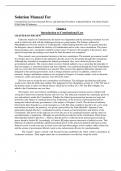Solution Manual For
Constitutional Law Governmental Powers and Individual Freedoms, Updated Edition, 4th edition Daniel
E Hall John P Feldmeier
Chapter 1
Introduction to Constitutional Law
CHAPTER OVERVIEW
Under the Articles of Confederation, the nation was fragmented and the national government was too
weak to effectively deal with the challenges facing our young nation. The Framers gathered in
Philadelphia to revise the Articles of Confederation. Understanding that their task was greater than this,
the delegates chose to abolish the Articles of Confederation and to write a new constitution. They knew
that presenting a new constitution would be controversial. To preserve the integrity of the process, they
agreed to keep their proceedings secret until the final document was completed.
They created a new governmental structure in the new constitution. The national government would
be stronger, but it was limited to the authorities directly given it by the people through the Constitution.
Although they intended to strengthen the federal government, they were careful to preserve local
governmental authority. The concern about excessive federal authority was so great that the principle of
dual sovereignty, or concurrent federal and state authority, was reinforced through the Tenth Amendment
only two years after the Constitution was enacted. Thus, powers that appeared inherently national were
delegated to the national government, such as foreign relations and war. In addition, control over
interstate, foreign, and Indian commerce was assigned to Congress. Everyday matters, such as intrastate
commerce, crime, and social concerns, were left to the states.
The first state to accept the new constitution was Delaware. The delegates decided that ratification
would occur when the ninth state ratified. This happened in New Hampshire on June 21, 1788. The last of
the thirteen states to ratify was Rhode Island, which did so on May 29, 1790. The Bill of Rights was
added to the Constitution one year later.
The framers were successful in establishing a stronger national government and are credited with
saving the Union from economic disaster and civil war. The federal government has continually grown in
size and authority under this Constitution. Whether the federal government has become too large and
powerful is the subject of continual discussion. Federalism, or the division of governmental powers
among the federal and state governments, is the subject of Chapters 2 and 8. The division of authority
between the three branches is a work in progress as well. But what could have proved to be a very weak
and ineffective branch, the judiciary, was given a power Boost by John Marshall‘s Supreme Court,
particularly through Marbury’s unabashed assertion of courts as final interpreters and arbiters of the
Constitution. The power of the judiciary to review the acts of its coordinate branches and the states for
constitutionality is significant. Although not specifically provided for in the Constitution, Chief Justice
John Marshall stated in Marbury v. Madison that the power is inherent in the general grant of judicial
power found in Article III. Accordingly, all Article III judges possess the power of judicial review. This
diffusion of authority establishes significant judicial power in the American political and legal systems.
Judicial review is used every day in courts across the land when judges review statutes, other written law,
and the actions of government officials (such as law-enforcement officers) for constitutionality
The framers‘ legacy extends well beyond having established the oldest written constitution in
continuous existence. Their ripple turned into a constitutional wave that has swept the world.
1
,CHAPTER OBJECTIVES
At the end of this chapter, you should be able to:
LO 1.1 Identify and discuss the important historical events and political philosophies that led to, and
shaped, the U.S. Constitution.
LO 1.2 Define constitutional law as an academic field of study.
LO 1.3 Define judicial review, discuss its political and legal histories, explain how it is an important
element of the U.S. rule of law, and contrast it with at least two other models from around the
world.
LO 1.4 Identify the major eras of the Supreme Court in the context of its approach to federalism.
LO 1.5 Identify the basic architecture and style of judicial opinions.
LECTURE OUTLINE
1.1 Constitutions and Rule of Law
1.2 Articles of Confederation
Teaching tip: To distinguish between the Federalist and anti-Federalist views, compare the
Federalist view, which was led by James Madison and Alexander Hamilton as wanting a unified
government for the entire country. The anti-Federalist view, led by Patrick Henry and George
Mason, felt that our country would be best served by leaving the power to the states. They did
not trust the ―unified government‖ view as they felt there was an element of secrecy among the
elitists. They fought for the states to retain their power.
1.3 Philadelphia Convention
1.3(a) The Delegates and Their Mandate
1.3(b) The Debates
1.3(c) Individual Rights and Slavery
1.3(d) Women and the Franchise
1.4 Ratification
1.5 Amendments
1.5(a) Original Copies of the Constitution and Bill of Rights
1.6 Values, Politics, and Constitutional Law
1.7 Judicial Review
1.7(a) Historical Basis
1.7(b) Congressional Action
Marbury v. Madison
Teaching tip: When discussing Marbury v. Madison, it is a nice visual to have the students think
that at this time, there was now an equal scale with three equal balanced parts. Before this case,
Congress and the President had the power, but this case allowed the Supreme Court to have
judicial review and the ability to void any acts of Congress that conflicted with the Constitution.
This was a huge decision that is still used today. It set our precedent of three equal parts.
2
, 1.7(c) Executive Action
United States v. Nixon
1.7(d) State Action
Martin v. Hunter’s Lessee
1.7(e) Shield or Sword?
1.7(f) A Diffused Model
1.7(g) An International Model
1.8 Judicial Eras
1.8(a) Early Court: The Least Dangerous Branch
1.8(b) Marshall Court: Expanding Federal Authority
1.8(c) Taney Court: States‘ Rights
1.8(d) Reconstruction Era: Federal Authority Expands
1.8(e) Pre–New Deal Era: Protecting Commercial Interests
1.8(f) New Deal Era: Expanding Federal Authority
1.8(g) Warren Court: Expanding Individual Rights
1.8(h) Burger Court: A Moderate Approach
1.8(i) Rehnquist Court: Protecting States‘ Rights
1.8(j) Roberts Court
1.9 The Court Today
1.10 Modern Challenges
ADDITIONAL ASSIGNMENTS AND CLASS ACTIVITIES
1. Explain what happens when a vacancy occurs on the Supreme Court. Does there have to be a certain
number of justices at any given time? What time limit is there to fill the vacancy? Write a short report
explaining these questions.
2. Do some research on the constitutional questions surrounding the COVID-19 pandemic in your state
and community. As government had implemented polices to fight the virus, what constitutional
challenges have been made to these efforts?
ANSWERS TO END OF CHAPTER ASSIGNMENTS
Review Questions
1. Continental Congress; Confederation Congress.
2. The Federalists supported the creation of a strong, centralized government while the anti-Federalists
desired to keep most power in the states.
3. The national government was both weak and ineffective under the Articles. Those powers which are
generally considered national were held by the national government, but it lacked the power to
enforce them. The power to declare war, but not to draft soldiers is an example. The power to enter
into treaties and alliances was thwarted by the power of the states to tax imports. There was no
3
, national executive, so enforcement of national law was weakened by its diffused nature within the
Confederation Congress. The national government could not raise revenues directly. There was no
national judiciary. Economic development was hindered by competing and contradictory state laws.
4. To revise the Articles of Confederation.
5. Rhode Island.
6. Virginia Plan or Virginia Resolves.
7. He believed that the federal judiciary would play a role in constraining state encroachments of federal
power.
8. The federal government is limited to those powers delegated to it in the Constitution. The states retain
all other powers. This principle finds its way into the Tenth Amendment, but through time the federal
government proves more powerful.
9. The delegates were split between those wanting to empower the states to elect the members of
Congress and those who wanted popular election. Bicameralism with popular election in one house
and state selection in the other was the compromise.
10. He believed that the power of the national government was limited and that it was unnecessary to
restrain it when it lacked the power. Further, he feared that an enumeration of rights could lead to an
interpretation that the rights of the citizens are limited to those listed. Later, the Ninth Amendment
would be included in response to this concern.
11. The power to review the actions of the legislative and executive branches (and state action) for
constitutionality and void those actions determined to be unconstitutional. Marbury v. Madison
12. The power is spread over all courts, state and federal.
13. In the United States, the courts engage in judicial review, while under the council model some
jurisdictions, a special constitutional council exercises the authority to review legislation for
constitutionality. It is only legislation that may be invalidated, not the actions of the executive branch
14. The Framers intended for it to be harder to amend the Constitution than to create legislation. The
Constitution is fundamental law, while legislation is not. The Constitution is intended to limit the
power of government, including Congress, and it would be counterproductive to vest the amendment
power in that body. The Constitution is founded upon a theory that there is an authority higher than
government: citizen sovereignty.
15. Answers will vary, but should demonstrate some reflection on the role of the judiciary and the
significance of (at the federal level) unelected officials making public policy.
Constitutional Law in Action
1. The Constitution in Your Community: Answers will vary depending on state. But students should be
able to cite a state case or two establishing or discussing the role of state courts and the power of
judicial review.
2. Going Federal: Students should be able to identify the primary Commerce Clause, Tax and Spending
Clause, and Federalism questions raised in the appellate challenges to the Affordable Care Act of
2010.
3. Moot Court: Students should be able to cite principles, cases, and doctrines from this chapter in
defending/challenging the scope of review of lower federal courts.
4






